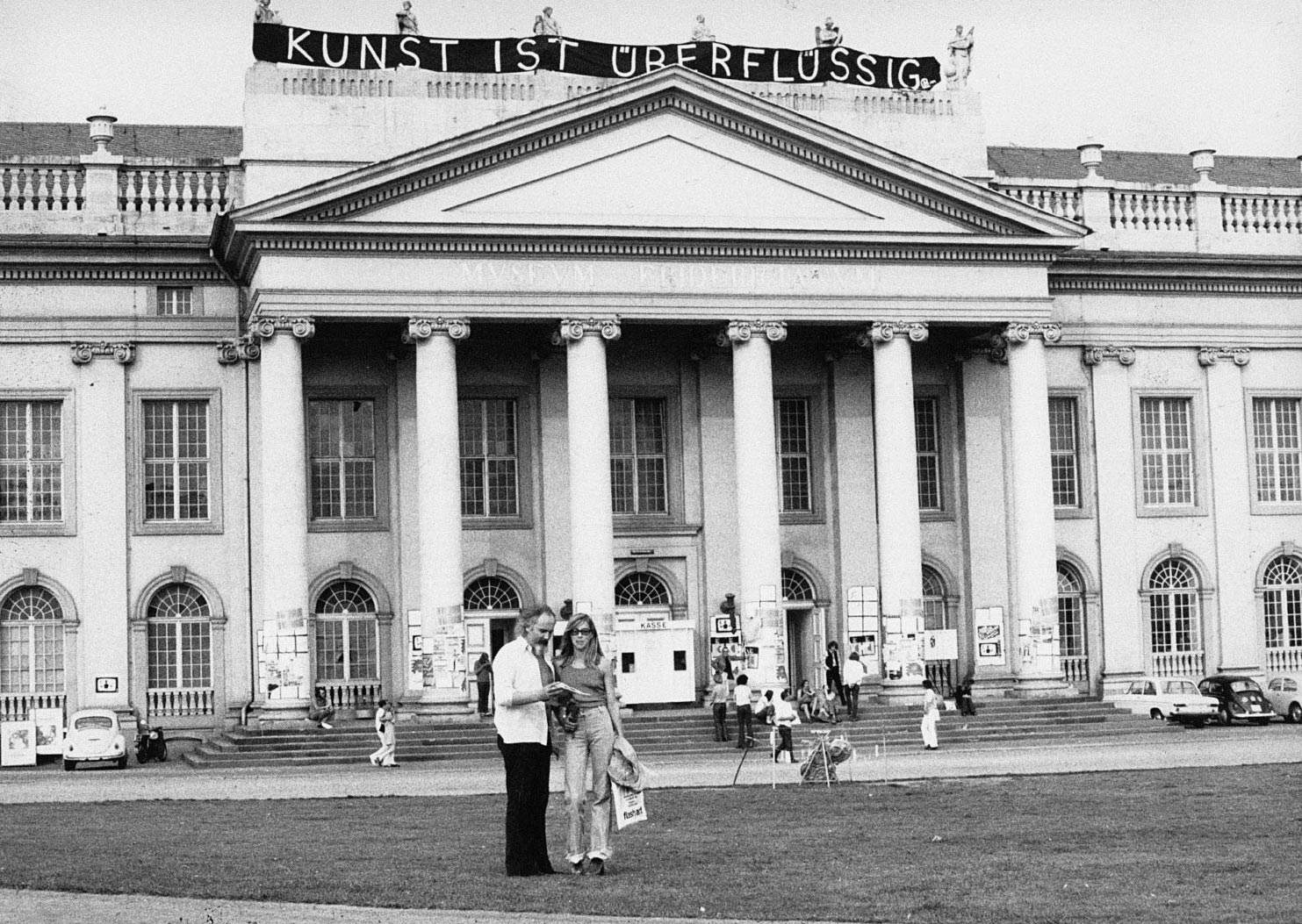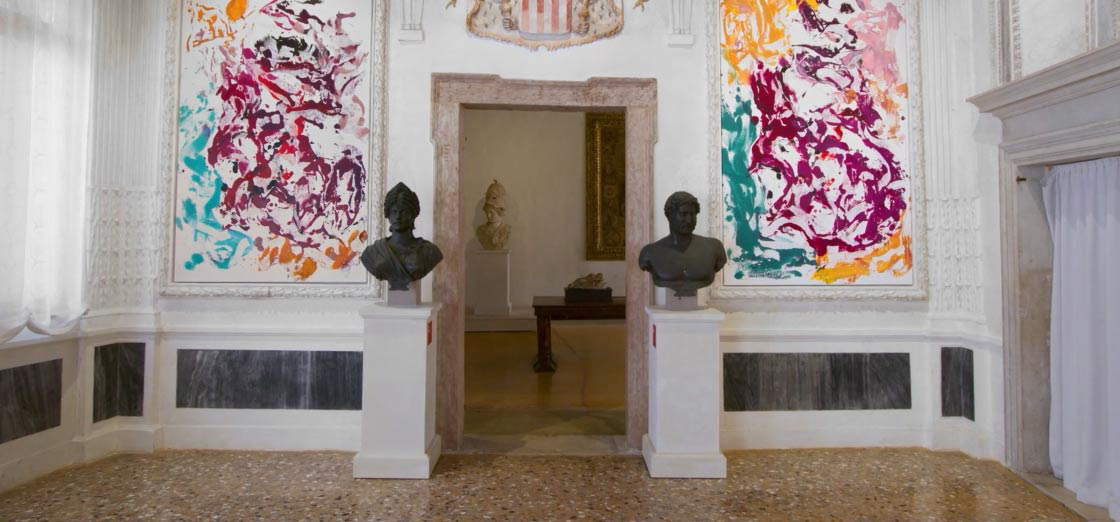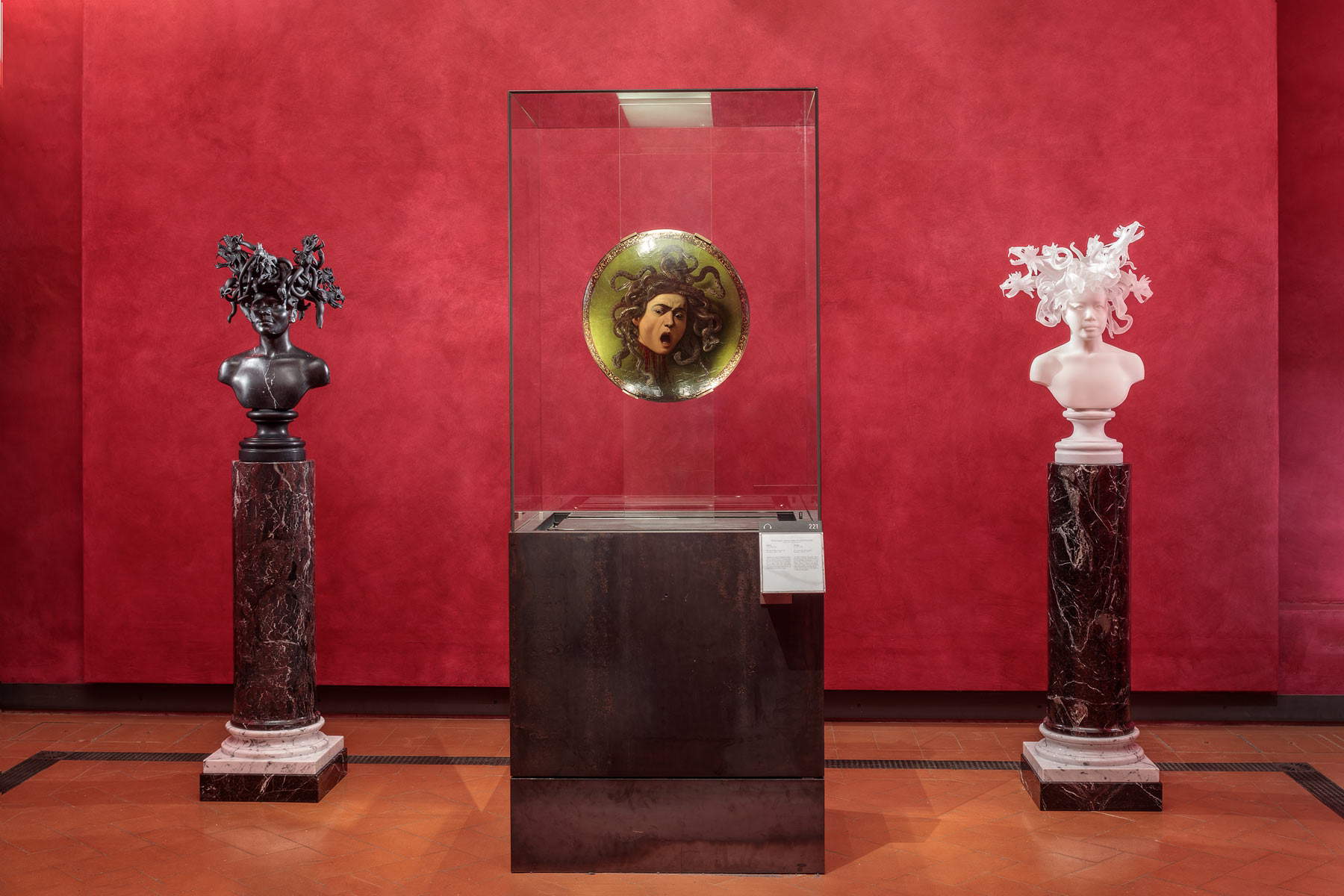Anyone visiting the Doge’s Palace in Venice until next Oct. 29 will not find in the Sala dello Scrutinio the works of Tintoretto, Andrea Vicentino, Pietro Liberi, Palma the Younger and the others who painted the splendors of the Serenissima on the large canvases arranged here to form a sort of frieze in praise of the Republic after the disastrous fire of 1577 destroyed this room and the nearby Salone del Maggior Consiglio: since March, everything has been covered by a huge Gagosian-branded installation by Anselm Kiefer, created specifically for this room, and imagined to respond, the presentation says, to a few specific purposes. First, “to highlight the role of contemporary art in reflecting on universal themes, transcending Venice to open up to current philosophical visions.” Second, “to measure the ability of this place-symbol of the Serenissima Republic to still be a center of living culture and not just memory.” Third, to establish a “narrative that brings to the surface the layering of millenary myths, solitudes and anxieties to which the artist gives form through a new epic, with accents as grave as is the darkness of our time.”
The visionary power of Kiefer’s work underlies a work that is certainly successful, although the German’s flames can be said to be metaphorical, whereas those of 1577 were real, and the rethinking of space did not spring from quiet, long-considered reflection, but from a most urgent necessity: and yet, despite the perceptible fiction, there emerged, Giuseppe Frangi wrote in the Manifesto, a “majestic and powerfully interrogative act, made possible thanks to a painting of extraordinary prodigality, where the monumentality of the execution is functional in restoring the intensity of the vision and the deep emotion for the fate of the world.” A result that was made possible, however, thanks to a double invasion: that of a contemporary artist who set out to insinuate himself into an ancient space that, for four centuries, has not known significant transformations (and perhaps for some, the idea of seeing a hall as it was when Venice was still an independent republic is a far more exciting experience than the sight of Kiefer’s ephemeral apparatuses), and that of a private gallery that has lavishly supported this occupation of public space.
We are not, of course, talking about a recent history: the contemporary intruding into the ancient is nothing new. The origins are perhaps to be traced back to Sculptures in the City, the event that, in 1962, filled the historic center of Spoleto with works by contemporary artists (raising even then the perplexities of Giovanni Urbani), some of which still remain today in the streets and squares of the Umbrian city. A further snapshot occurred, still in Spoleto, in 1968, when Christo and Jeanne-Claude presented the first wrapping on an ancient monument: for the Festival of the Two Worlds, the couple decided to entirely cover the Fortilizio dei Mulini and the fountain in Piazza del Mercato. If, on the other hand, one wished to avoid considering a work of art that could not exist without a precise action on an ancient monument, then one can take a four-year leap to 1972: the fifth edition of Documenta was then being held, and the French artist Ben Vautier covered the columns of the eighteenth-century Fridericianum in Kassel (an idea that would later characterize almost every edition of the exhibition), and hoisted above the pediment a large banner that read “Kunst ist überflüssig,” “Art is superfluous.” It will perhaps not be necessary to specify how the Venice Biennale was also anticipatory: it will be worth recalling the many times when, starting in the 1980s, thus in the midst of the postmodern climate when these modes of interaction between the ancient and the contemporary began to be widely disseminated throughout Europe, the church of San Stae was assailed by incursions of contemporary artists: from Felice Varini who installed a platform to construct a precise point of view to Adrian Schiess who covered the floor with colored panels, from Christoph Rütimann who with a large white installation drastically reduced the interior of the church to Pipilotti Rist who cast a video projection on the ceiling. A large body of interventions whose memory has largely been lost today.





However, there have been no missed opportunities to multiply the invasions of contemporary artists within ancient contexts, reduced more and more to the mere role of scenarios, of backdrops with which to establish a “dialogue,” a much abused term with which curators like to season their phrasing to justify presences that often have nothing to share, or nothing on which they can “dialogue,” with the ancient that hosts them. We are not talking here about installations inside places that have lost much of their original physiognomy, and that consequently, having become empty or semi-empty containers, have undergone interesting operations of re-functionalization thanks to the presence of contemporary works. The most famous case, and perhaps among the most successful, is Gino de Dominicis’s Cosmic Magnet, which since 2011 has occupied the entire nave of the former Trinity Church in Foligno, over the centuries stripped of all its furnishings and reduced to a mere architectural structure.
However, cases also abound in which contemporary art is rampant in places that have retained good or even full legibility. Fishing only among the most recent examples, one could mention Georg Baselitz’s Archinto project (another exhibition produced by Gagosian, by the way), which brought some of his paintings to the Sala del Portego of Palazzo Grimani in Venice, going to occupy the frames that once housed the portraits of the Grimani family with works animated by a neo-expressionist language that has little to share with the hall that houses them. One could, of course, make an objection: Palazzo Grimani has lost most of its furnishings, including paintings, and without contemporary art the ancient stuccoes would remain empty. Which is true, but it is not necessarily the case that a forcing works better than an environment left bare. Besides, emptiness often has a specific function. Take the case of the Cappella dei Notai in Verona, which has become the site of the exhibition of the winners of the “Level 0” prize, with the works being displayed, beneath the sumptuous 17th-century paintings by Louis Dorigny, Alessandro Marchesini, Giambattista Bellotti, and Santo Prunati, in the space where the altar, dismembered in the 19th century, once stood: the empty space is a precise sign of what occupied that wall in the distant past, and for which Dorigny imagined his Annunciation, executed also with the aim of bringing to life an intense scenographic and illusionistic apparatus. That void now houses contemporary artworks that have little or nothing to do with the space that hosts them, as in the case of the astronaut by the young Andrea Carpita, a jarring presence, completely foreign to the environment of the Notary Chapel, unable to activate those “reflections on the cosmos, human existence and the transcendent” that the presentation text intends to evoke. Rather, its presence appears to be that of a tourist who has climbed over the bollard that protects Dorigny’s paintings.
However, there are also instances of filling rooms that are not bare: the example of the exhibition at the Royal Palace of Turin by the now ubiquitous Fabio Viale, who plumbed his reimagining of Canova’s Cupidand Psyche in the Salon of the Swiss Guards, to urge visitors “to look with new eyes at the masterpieces of sculpture that populate our museums and our imagination” (thus the director of the Royal Museums, Enrica Pagella), and to establish “a tribute to the multifaceted potential of cultural heritage and an invitation to know and challenge it without prejudice.” In the exhibition presentation, a comparison was established precisely with Christo and Jeanne-Claude’s art: the relationship with the context, the text reads, “forces one to reread the subject with new eyes.” A debatable comparison: the difference between Christo and Jeanne-Claude’s interventions and those of Kiefer and Viale lies in the fact that in the nouveau réaliste poetics of the French-Bulgarian couple, the new work cannot come into being without the presence of the old one, since the meaning of Christo and Jeanne-Claude’s conceptual operation lies in the very concealment of the old work. And if Kiefer is an artist who has always worked without directly intervening on the ancient (even These writings, when burned, will finally give some light, the installation at the Ducal Palace, although created for that precise site, has extrinsic origins, and would probably have worked well in another place), the sculptures that Viale brought to Turin were born regardless of that context, and therefore the idea of referring to Christo and Jeanne-Claude sounds a little like an ex post facto justification. And also well readable is the church of Sant’Agostino in Pietrasanta, the scene for years of contemporary art exhibitions, which, however, often get in the way of the sacred furnishings, or are completely disrespectful of the context (the most recent case being the current exhibition with Marco Cornini’s terracottas depicting young women in provocative attitudes, arranged under the altarpieces of Francesco Curradi, Astolfo Petrazzi and other protagonists of the Tuscan seventeenth century: another presence that has nothing to do with its setting, that adds nothing to a perfectly preserved church, and that does not activate any “dialogue,” much less bring out new readings for disagreement). And it will then be convenient to keep silent about all the times that modern works have entered the rooms of the Borghese Gallery, which are already ill-suited for temporary exhibitions: suffice it to recall the exhibition that compared two extremely distant artists, Bacon and Caravaggio, even starting from the stated assumption that the review did not move “from a historical-critical hypothesis of filiation” or from a “philological exercise that derives Bacon’s ispitation from Caravaggio,” but was motivated simply by the “invitation to make an aesthetic experience.”
This is not a matter of moralism (a Kiefer is not worth less than an Andrea Vicentino and does not need to invade the Doge’s Palace to establish himself), nor of preclusion against the contemporary, because dialogue often works: one can cite, again among the latest cases, the new stained glass windows of the Cappella dei Priori in Perugia, created by Vittorio Corsini, who has intervened while respecting the environment and creating two works capable of effectively evoking the history of the building, or again the exhibition of Koen Vanmechelen at the Uffizi this year, with the presence of some works that, through analogies, divergences and necessary actualizations, tried to address themes and problems posed by the ancient works in the gallery, or, demonstrating that a proper dialogue is possible even in a difficult environment, the Bertozzi&Casoni exhibition held in 2020 in the very church of Sant’Agostino in Pietrasanta. The two masters of ceramics, in that case, managed to overcome a difficult challenge with a minimal intervention, capable of not clashing with the seventeenth-century church, and by posing (as after all it should always be) a problem of a semantic nature, with the idea of establishing a profound confrontation with the surrounding environment starting first of all from the plane of meaning: the works, in that case, questioned the value and role that the Church, and human beings in general, attribute to time.







A dialogue between ancient and contemporary can and should exist. And it is healthy for a museum of ancient art to question whether it can also be a place of production of the languages of the present, as well as of preservation of the past. It is the fruit of clichés that we have been dragging behind since the age of futurism to think that between ancient and contemporary there are irremediable rifts, discontinuities, and incapacity for dialogue: contemporary art cannot disregard the confrontation, even implicit or implied, with ancient art. Every art form more or less intentionally includes some form of reaction which, Salvatore Settis explained, “can also manifest itself by turning the echoes of ancient art upside down, hiding its traces, trying to ignore its existence or denigrate its qualities and outcomes, or even advocating its destruction as the Futurists did,” and consequently the relationship between ancient and contemporary is animated by a tension that “continually rearticulates itself in the flow of critical languages and taste, in the mechanisms of the market, in the functioning of institutions, in ’popular culture.’”
How then to activate a co-presence of ancient and contemporary that is not specious? It will be necessary, in the meantime, to start from the assumption that one function should not exclude another (it is legitimate to wonder whether a place of memory can also be a place of production, but if production for some time hides part of the memory perhaps it is necessary to check first of all to what extent one’s desires can be compatible with the primary function of the place), and to remark that the mere resumption of formal values (either by affinity, or by contrast) hardly succeeds in being incisive: the logic of the contemporary intervention that activates “an aesthetic experience” in comparison with the ancient (sounds a bit like “contemporary works fit us”), does not prescind from considering the latter as a mere setting. It will then be necessary for the contemporary to avoid obliterating the ancient or preventing it from being read: if dialogue is involved, the contemporary should, if not exalt the interlocutor, at least make him participate, involve him on the same level, otherwise it will no longer be dialogue, but will become prevarication. The so-called “dialogue” should then rest on solid foundations: a link with the history of the place, an obvious and perhaps spontaneous and unforced connection with the ancient work, or a reflection that starts from the ancient or at least has common ground. Dialogue, at any rate, is certainly not the only possible form of interaction: presence in dissonance with ancient art is another equally valid form of juxtaposition, perhaps to question an argument posed by the ancient. What matters is that the approach, even discordant, of ancient and contemporary ends up leaving something more, to produce new meanings and new readings. In 2006, Paolo Portoghesi, speaking on the theme of contemporary inserts in ancient urban fabrics, outlined with lucid clarity what that any intervention of this kind should not admit generic justifications, but on the contrary presuppose “reasons closely linked to a specific problem addressed in 360 degrees before taking any decision”: the same principle should guide contemporary art interventions that confront the ancient.
Warning: the translation into English of the original Italian article was created using automatic tools. We undertake to review all articles, but we do not guarantee the total absence of inaccuracies in the translation due to the program. You can find the original by clicking on the ITA button. If you find any mistake,please contact us.